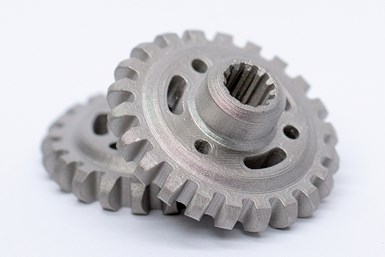Desktop Metal Qualifies Nickel Alloy for Additive Manufacturing
Nickel alloy Inconel 625 prints and sinters parts in a two-step process for metal extrusion 3D printing.
Share
Read Next
The IN625 was developed to provide high-strength, high-performance flexibility. Photo Credit: Business Wire
Desktop Metal has qualified the use of IN625 for its Studio System, which is a turnkey metal 3D printing platform designed to offer customers an easy way to print high-performance metal parts in low volumes for preproduction and end-use applications.
The company says it Studio System platform now offers more materials than any other metal extrusion 3D printing system on the market, a total of eight in all. In addition to IN625, sytem users can now print titanium alloy Ti6Al4V (Ti64), copper, 4140, two tool steels (H13 and D2), and two stainless steels (17-4PH and 316L).
It is said the Studio System 2 features a streamlined and easy-to-use, two-step process, making it a flexible metal 3D printer. The company says it gives manufacturers the agility of on-site, on-demand metal production and adding IN625 to the portfolio only amplifies the system’s flexibility.
The IN625 was developed to provide high-strength, high-performance flexibility. According to the company, IN625 is a high-performance nickel alloy known for high levels of strength, temperature resistance and corrosion resistance — making it a well suited for applications in the aerospace, chemical processing and offshore energy industries.
However, the company says the strength of IN625 is also what makes it a difficult and expensive material to machine into complex shapes. The process typically requires a skilled machinist and special CNC cutting tools, strategies and coolants to shape. It is said it’s not uncommon for cutting tools to be broken or deformed when milling Inconel stock or for the material to deform when the outer layer hardens too quickly in response to machining.
Alternatively, the company says producing IN625 parts with the Studio System 2 is fast, safe and affordable. Users can directly print and sinter final, end-use parts or near-net shape parts that can be precision machined for key surfaces with ease.
The Studio System 2 is designed as an office-friendly metal additive manufacturing system. It is said the easy, two-step process provides a nearly hands-free experience, while eliminating loose powders and dangerous lasers commonly associated with metal 3D printing, the company says. Consisting of a printer and furnace, the Studio System 2 is said to simplify in-house, low-volume production of a wide range of complex geometries with outstanding surface finish and high-performance mechanical properties.
Related Content
-
Beehive Industries Is Going Big on Small-Scale Engines Made Through Additive Manufacturing
Backed by decades of experience in both aviation and additive, the company is now laser-focused on a single goal: developing, proving and scaling production of engines providing 5,000 lbs of thrust or less.
-
3D Printed Titanium Replaces Aluminum for Unmanned Aircraft Wing Splice: The Cool Parts Show #72
Rapid Plasma Deposition produces the near-net-shape preform for a newly designed wing splice for remotely piloted aircraft from General Atomics. The Cool Parts Show visits Norsk Titanium, where this part is made.
-
Additive Manufacturing Is Subtractive, Too: How CNC Machining Integrates With AM (Includes Video)
For Keselowski Advanced Manufacturing, succeeding with laser powder bed fusion as a production process means developing a machine shop that is responsive to, and moves at the pacing of, metal 3D printing.
















